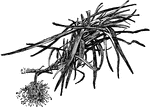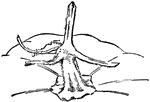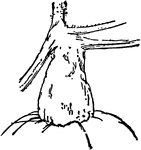
Caragana Microphylla
The caragana microphylla shrub grows four to six feet tall. Each stem has one or two yellow longs.

Cardiospermum Halicacabum
The common name of cardiospermum halicacabum is balloon vine but it is also know has heart seed and…

Carnation Cuttings
Illustrated are cuttings of carnation. (a) desirable cuttings, (b) weak cutting that is too high up…

Cattleya Citrina
The flowers of cattleya citrina are yellow except for the white border of the front lobe of the lip.…

Centaurea Moschata
The common name of centaurea moschata is sweet sultan. The stem is two feet tall and branching below.…

Chimaphila Maculata
The common name of chimaphila is pipsissewa. The maculata variety has white flowers. There are two to…
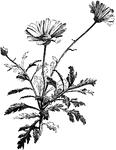
Paris Daisy
The Paris or Marguerite daisy is the common name of chrysanthemum frutescens. It is a perennial that…

New Type of Chrysanthemum
Illustrated is a new type of chrysanthemum with a short stem. It is popular with commercial growers.
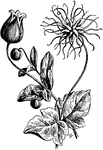
Clematis Viorna
Clematis viorna grows eight to ten feet tall. The flowers are pitcher shaped and grow alone on each…

Clerodendron Fallax
Clerodendron fallax is an ornamental species. The stem is erect, shrubby, and branching after flowering.…
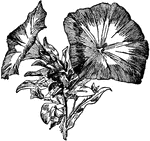
Convovulus Tricolor
Convovulus tricolor grows six to twelve inches tall. The stem is covered with long, brownish hairs.…
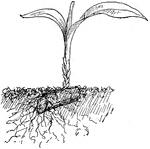
Cordyline
Illustrated is a stem cutting of cordyline. The common names are dracena and dracena palm.

Crepis Rubra
The flowers are crepis rubra are red and usually grow alone at the end of each stem. It grows between…
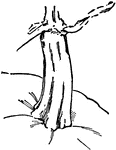
Pumpkin Stem
Illustrated is the stem of an early sugar pumpkin. It is the common name of curcurbita pepo.
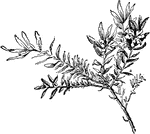
Cuphea Hyssopifolia
Cuphea hyssopifolia has a shrubby stem and numerous branches. The flowers are scarcely longer than the…

Cymbopetalum Penduliflorum
The flowers of cymbopetalum penduliflorum grow alone at the end of each stem. The petals and thick and…
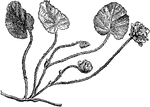
Dalibarda Repens
The leaves of dalibarda repens are heart shaped and wavy toothed. The flowers are white with one or…

Delphinium Formosum
Delphinium formosum has a strong stem that grows two to three feet tall. The flowers are blue with indigo…

Didymochlaena Lunulata
Didymochlaena lunulata is native from Cuba to Brazil. The leaves are clustered from an erect, rigid…

Promethea Moth Cocoon
The cocoon of the promethea moth is made in the roll of a leaf. The insect weaves a web around the leaf…

Drosera Rotundifolia
Drosera rotundifolia is a carnivorous plant. Each stem has five to twelve flowers. The flowers are white…

Exacum Macranthum
Exacum macranthum flowers are purplish blue and two inches across. The stem is cylindrical and slightly…

Laelia Cinnabarina
Laelia cinnabarina is native to Brazil. The flowers are reddish orange. The stem has four to five flowers.
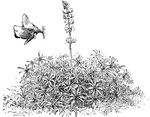
Lupinus Luteus
The common name of lupinus luteus is yellow lupine. The stem is two feet tall. hairy, and erect. The…
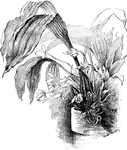
Lycaste Aromatica
Lycaste aromatica is native to Mexico. Each stem has one flower. The flowers bloom in winter and spring.

Masdevallia Muscosa
Masdevallia muscosa is native to Ecuador and Colombia. The stem is hairy and bears a yellow flower.…
Hair Cap Moss
Hair cap moss is the common name of polytrichum commune. The spore cases or capsules arise from the…

Grape Hyacinth
The flowers of grape hyacinth are pale blue and odorless. The flowering stem is six to nine inches long.
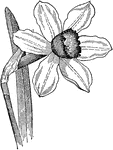
Narcissus Incomparabilis
There is always one narcissus incomparabilis flower per stem. The flowers are not fragrant. The plant…

British Golden-rod
British Golden-rod is a member of the large composite genus Solidago, which is chiefly North American.…

Juncus Effusus
Known as the soft rush, Juncus effusus is nearly as common as the most common species, J. conglomeratus.…

Softening Process in the Manufacturing of Jute
In the manufacturing of jute, the jute fiber must first be softened. The softening machine consists…

Lamium Album
Lamium album (also known as the white dead-nettle, or archangel) is a member of the Lamium, a genus…
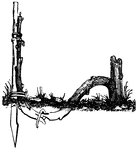
Layering Method of Plant Propagation
Layering is a method of plant propagation by which a part of the plant is bent down and covered with…
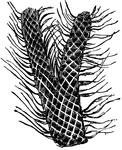
Portion of Lepidodendron
This illustration shows a portion of Lepidodendron. Lepidodendron is the generic name of a large and…
Sugar Cane
A sugar cane stem. A are buds or eyes, B are joints, C are nodes, D are internodes, and X are dots where…

Prickly Saltwort
Salsola kali. This plant is also called a Russian Thistle, Prickly Glasswort, Tumbleweed, and Glasswort.…
Ryegrass Leaf with Sheath
Lolium perenne. A sheath, in botany is "the part of an expanded organ that is rolled around a stem or…
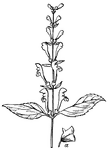
Skullcap - Upper Part of the Flowering Stem
"A plant of the genus Scutellaria: so called from the helmet-like appendage to the upper lip of the…
Seneca Snakeroot - Stem and Flowers
"Polygala senega of eastern North America. It sends up several stems from hard knotty root-stocks, bearing…
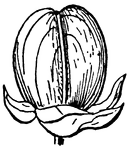
Seneca Snakeroot - the Fruit
"Polygala senega of eastern North America. It sends up several stems from hard knotty root-stocks, bearing…

Seneca Snakeroot - Roots and Base of the Stem
"Polygala senega of eastern North America. It sends up several stems from hard knotty root-stocks, bearing…
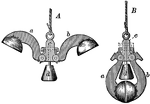
Taselli's Sounding Apparatus with Cups Opened and Closed
"To measure the depth of; fathom; try or test, as the depth of water and the quality of the ground,…

Sow Thistle - Stem with Heads, Basal Leaves, Flower, Achene with Pappus
"A plant of the genus Sonchus, primarily S. oleraceus, a weed of waste places, probably native in Europe…

Spiderwort Inflorescence
Tradescantia virginica. "It is a native of the central and southern United States, and was early introduced…
